
Entomology is the scientific study of insects, a branch of zoology. In the past the term insect was less specific, and historically the definition of entomology would also include the study of animals in other arthropod groups, such as arachnids, myriapods, and crustaceans. This wider meaning may still be encountered in informal use.

Hemiptera is an order of insects, commonly called true bugs, comprising over 80,000 species within groups such as the cicadas, aphids, planthoppers, leafhoppers, assassin bugs, bed bugs, and shield bugs. They range in size from 1 mm (0.04 in) to around 15 cm (6 in), and share a common arrangement of piercing-sucking mouthparts. The name "true bugs" is often limited to the suborder Heteroptera.
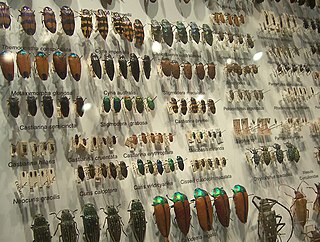
Insect collecting refers to the collection of insects and other arthropods for scientific study or as a hobby. Most insects are small and the majority cannot be identified without the examination of minute morphological characters, so entomologists often make and maintain insect collections. Very large collections are conserved in natural history museums or universities where they are maintained and studied by specialists. Many college courses require students to form small collections. There are also amateur entomologists and collectors who keep collections.

Francis Walker was an English entomologist. He was born in Southgate, London, on 31 July 1809 and died at Wanstead, England on 5 October 1874. He was one of the most prolific authors in entomology, and stirred controversy during his later life as his publications resulted in a huge number of junior synonyms. However, his assiduous work on the collections of the British Museum had great significance.
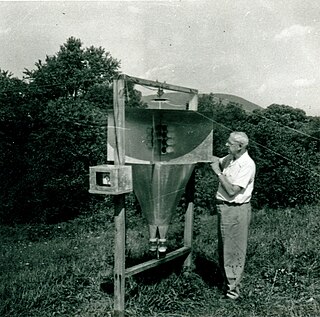
Stuart W. Frost (1891–1980) was a professor of entomology at The Pennsylvania State University, University Park, Pennsylvania. He was born in Tarrytown, New York, and graduated from Cornell University. He was a specialist in leaf-mining flies (Diptera). The Frost Entomological Museum at Penn State was named in his honor.
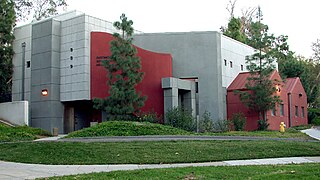
The Entomology Research Museum is the insect collection of the Department of Entomology of the University of California, Riverside. It contains approximately 4 million total insect specimens, over 3 million of which are pinned, roughly 400,000 mounted on slides, the remainder preserved in ethanol. Of the ~4 million curated holdings, approximately 75% of are identified to genus level or better. An estimated 25% of the entire collection are Hymenoptera, 21% are Coleoptera, 18% Diptera, and 18% Lepidoptera.

Zelus bilobus is a species of assassin bug found in Florida.

Myzus persicae, known as the green peach aphid, greenfly, or the peach-potato aphid, is a small green aphid belonging to the order Hemiptera. It is the most significant aphid pest of peach trees, causing decreased growth, shrivelling of the leaves and the death of various tissues. It also acts as a vector for the transport of plant viruses such as cucumber mosaic virus (CMV), potato virus Y (PVY) and tobacco etch virus (TEV). Potato virus Y and potato leafroll virus can be passed to members of the nightshade/potato family (Solanaceae), and various mosaic viruses to many other food crops.

Thomas Blackburn was an English-born Australian priest and entomologist who specialized in the study of beetles.

James Halliday McDunnough was a Canadian linguist, musician, and entomologist best known for his work with North American Lepidoptera, but who also made important contributions about North American Ephemeroptera.

A zoological specimen is an animal or part of an animal preserved for scientific use. Various uses are: to verify the identity of a (species), to allow study, increase public knowledge of zoology. Zoological specimens are extremely diverse. Examples are bird and mammal study skins, mounted specimens, skeletal material, casts, pinned insects, dried material, animals preserved in liquid preservatives, and microscope slides. Natural history museums are repositories of zoological specimens

The Bohart Museum of Entomology was founded in 1946 on the campus of the University of California, Davis. The museum is currently the seventh largest insect collection in North America with more than seven million specimens of terrestrial and freshwater arthropods. At least 90% of these holdings are insects. The collection is worldwide in scope with the Western Hemisphere, Indonesia, and Australasia particularly well represented.
The concept of a system for filing and for the cross-referencing of specimen, collection, and identification information, was first advanced by A. D. Hopkins in 1894. The System was formally initiated by the U.S. Department of Agriculture in 1902 by Hopkins himself, who was subsequently named Chief of Forest Insect Investigations. It was still in use in 1987 by more than twenty Forest Service units of Forest Insect and Disease Research and Forest Pest Management, and by the Agricultural Research Service Systematic Entomology Laboratory (ARS-SEL). A salient feature or the System was the controlled assignment of “Hopkins numbers” to avoid redundancy within or between field units. These unique numbers allow for the keying of records, an essential pre-requisite for the creation of a proper relational database.

The Department of Entomology is a research department and collection unit of the Smithsonian Institution's National Museum of Natural History (NMNH), located in Washington, D.C. The department houses the U.S. National Insect Collection, one of the largest entomological collections in the world, with over 35 million specimens housed in 132,354 drawers, 33,000 jars or vials, and 23,000 slides in more than 5,200 cabinets. The department also includes research scientists and technical staff from the Smithsonian Institution, the United States Department of Agriculture Systematic Entomology Lab (SEL) and United States Department of Defense Walter Reed Biosystematics Unit (WRBU).
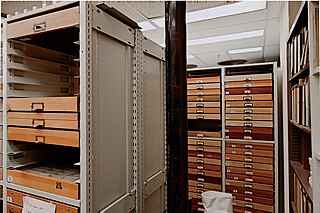
The Essig Museum of Entomology is a research museum dedicated to terrestrial arthropods, located at the University of California at Berkeley. It contains perhaps the world's largest collection of California insects and has been ranked among the top university-based collections in North America. The museum is open to the public twice per year.
Louise M. Russell was a US Department of Agriculture entomologist renowned for her expertise in insect identification and research on using parasites for biocontrol.

The conservation and restoration of insect specimens is the process of caring for and preserving insects as a part of a collection. Conservation concerns begin at collection and continue through preparation, storage, examination, documentation, research and treatment when restoration is needed.
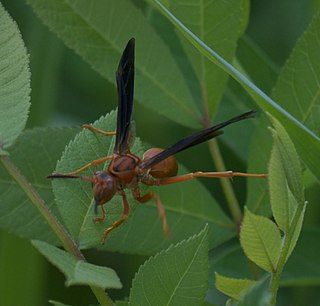
Polistes rubiginosus is one of two species of red paper wasp found in the eastern United States and is noted for the coarser ridges on its propodeum. It is a social wasp in the family Vespidae. Until taxonomic revision by Matthias Buck in 2012, P. rubiginosus was long known under the name P. perplexus. It occurs northernmost from Maryland, Pennsylvania to northern Ohio, south to Florida, and from there west to central Illinois, Kansas, Oklahoma, Texas and Arizona.

The Lincoln University Entomology Research Collection is a collection of approximately 500,000 insect, spider, and other arthropod specimens housed in Lincoln University, New Zealand. One of New Zealand's largest insect research collections, it is the only one based in a university.

Theodore Pergande was a German-born American entomological pioneer known for his skills in rearing insects. He made careful observations on aphids and thrips and made collections and studies on North American ants, several of which, including the harvester ant Messor pergandei and the scale insect Parlatoria pergandii, have been named after him.



















